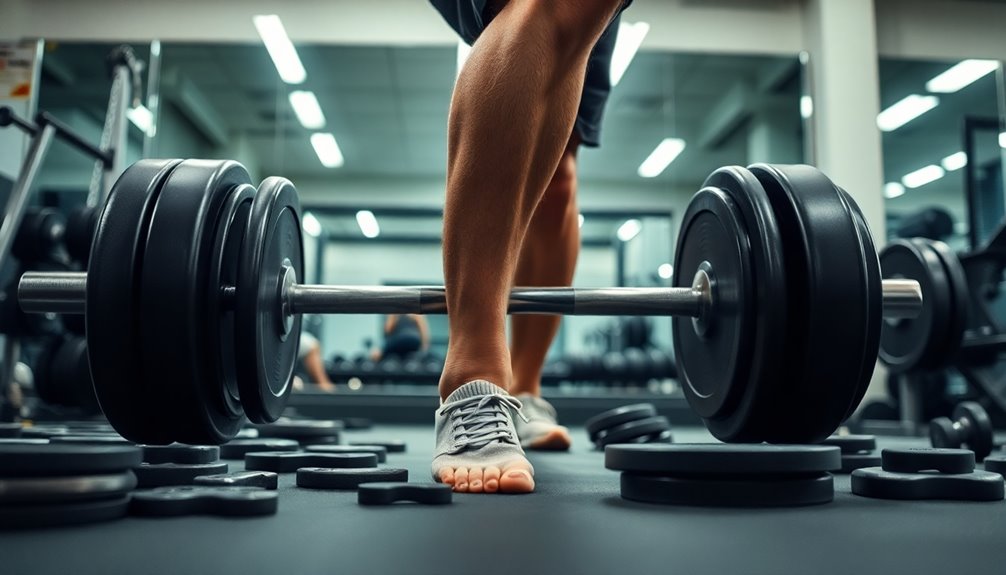To avoid common mistakes when lifting weights, focus on maintaining proper form and technique. Don't overlook your warm-up and cool-down phases; they're crucial for preventing injuries and aiding recovery. Resist the temptation to lift too heavy too soon; progressive overload is the key to building strength safely. Pay attention to balance and symmetry to enhance performance and reduce injury risk. Finally, make consistency a priority in your workout routine and make sure you're allowing enough time for rest and recovery. Stay tuned to discover more tips that can help enhance your weightlifting game even more!
Key Takeaways
- Using improper form can lead to injuries; prioritize body alignment and breathing techniques during lifts.
- Lifting weights that are too heavy too soon increases the risk of setbacks; focus on progressive overload.
- Neglecting warm-up and cool-down routines can hinder recovery; incorporate dynamic stretches and mobility exercises consistently.
- Ignoring proper nutrition may limit performance and recovery; fuel your body appropriately to support your workouts.
- Failing to maintain consistency in your workout schedule can disrupt progress; treat each workout as an essential appointment.
Poor Form and Technique

When it comes to lifting weights, using poor form and technique can lead to injuries and hinder your progress. You might think you're pushing yourself to the limit, but if your body alignment isn't right, you're setting yourself up for trouble. This isn't just about looking good in the gym; it's about staying safe and getting the most out of your workouts.
To start, focus on maintaining proper body alignment. Your spine should be neutral, shoulders rolled back, and knees aligned with your toes. This alignment helps distribute the weight evenly, preventing undue stress on your joints. Remember, it's not just about lifting heavy; it's about lifting smart.
Incorporating proper breathing techniques is equally important. You should exhale during the exertion phase of your lift and inhale as you lower the weight. This rhythm not only gives you the strength to power through but also keeps your core engaged, providing additional support for your lift.
Additionally, using tools like mini bands can enhance your workouts by providing unique challenges with elastic resistance, which can effectively tone muscles while reducing joint pressure.
When you prioritize proper form and technique, you're not just avoiding injuries; you're also building a solid foundation for progression. It might feel challenging at first, but as you refine your technique, you'll discover new levels of strength and confidence.
You belong in this journey, and every small improvement is a step toward achieving your goals. So, take a moment to check in with your body, breathe deeply, and embrace the process of lifting smarter, not just harder.
Ignoring Warm-Up and Cool Down

Neglecting pre-workout and post-workout routines can undermine all the hard work you put into your weightlifting sessions. Skipping these essential steps not only increases your risk of injuries but also hampers your performance gains. You want to be part of a community that thrives on progress, so let's make sure you're taking the right steps to keep yourself safe and effective.
Here's a quick reference table to illustrate the importance of warming up and cooling down:
| Pre-Exercise Activities | Benefits | Post-Exercise Activities |
|---|---|---|
| Dynamic stretches | Boosts blood flow | Static stretches |
| Light cardio (5-10 mins) | Prepares muscles and joints | Low-intensity cardio |
| Mobility exercises | Enhances flexibility | Aids in recovery |
| Activation drills | Readies muscles for lifting | Minimizes muscle soreness |
| Sport-specific movements | Enhances coordination | Restores heart rate |
By incorporating pre-exercise exercises, you're actively preventing injuries while improving performance during your lifting routine. These activities prepare your body, making sure that your muscles are ready to handle the workload ahead. Additionally, a proper warm-up can improve overall performance, which is crucial for achieving your fitness goals.
Likewise, cooling down helps your body transition back to a resting state. It aids in muscle recovery, keeping you in the game longer and feeling great after your workouts. Embrace these routines as vital parts of your fitness journey, and you'll find that not only do you lift better, but you also feel more connected to your goals and community.
Lifting Too Heavy Too Soon

Progress is exhilarating, but lifting too heavy too soon can lead to setbacks that hinder your journey. Many people want to see quick results and might feel tempted to load up the weights before they're ready. However, this approach can lead to injuries that may keep you sidelined for weeks or even months. Instead, focus on proper progression through the principle of progressive overload.
Progressive overload means gradually increasing the weights you lift, allowing your body to adapt and grow stronger over time. It's pivotal to start with a weight that challenges you but still lets you maintain good form. You'll build a solid foundation and confidence this way, making your progress sustainable and consistent.
As you become comfortable with your current weight, increase it in small increments. This method not only enhances your strength but also minimizes the risk of injury. Remember, every lifter's journey is unique, and comparing yourself to others can lead to poor decisions. It's about celebrating your own progress, no matter how small it seems.
Stay connected with your body and listen to its signals. If you're struggling to complete a set or your form starts to break down, it's a clear sign that you need to scale back. Embrace the journey of lifting weights, and recognize that real strength comes from patience and dedication. You're part of a supportive community that understands the value of steady progression and the benefits of a strong core.
Neglecting Balance and Symmetry

Many lifters overlook the significance of balance and symmetry in their training routines, which can lead to imbalances and injuries over time. You might focus on lifting heavier weights or hitting specific muscle groups, but neglecting these aspects can impede your progress and overall strength. Establishing balance isn't just about aesthetics; it's vital for your performance and safety.
One effective way to improve balance is by incorporating functional movements into your workouts. Exercises like squats, lunges, and deadlifts engage multiple muscle groups and promote stability. They train your body to work as a cohesive unit, enhancing your core stability and preventing disproportionate muscle development.
When you focus on functional movements, you'll not only build strength but also enhance your coordination and agility in everyday activities.
To make sure you're maintaining symmetry, consider alternating your exercises. For instance, if you perform a set of bench presses, follow it up with rows to target opposing muscle groups. This approach helps maintain balance in your physique and reduces the risk of injury.
Skipping Rest and Recovery

While focusing on balance and symmetry is important, don't underestimate the power of rest and recovery in your weightlifting routine. Recovery is where the magic happens; it's when your muscles repair, grow stronger, and get ready for your next workout.
You might feel tempted to push through every session, thinking it'll bring quicker results, but this mindset can lead to burnout.
The importance of recovery can't be overstated. Your body needs time to heal from the stress of lifting weights. When you skip rest days, you increase the risk of overtraining, which can lead to injuries, fatigue, and a decline in performance.
You might find yourself feeling weaker rather than stronger, and that's not what you want on your fitness journey.
Incorporating rest into your routine isn't a sign of weakness; it's a smart strategy that shows you're committed to long-term success. Think of it as part of the training process, not a break from it. Whether it's a full day off or lighter activities like stretching or yoga, these moments of recovery are essential. Furthermore, allowing your glutes to recover properly can prevent issues such as Piriformis syndrome, ensuring you maintain optimal movement efficiency and performance.
Inconsistent Workout Routine

Consistency is key when it comes to achieving your weightlifting goals. If you're hitting the gym sporadically, you're likely missing out on the progress you crave. An inconsistent workout routine not only hampers your strength gains but can also lead to frustration. You want to feel strong and capable, and that starts with committing to a regular schedule.
To build a habit, set specific days and times for your workouts, treating them like unmissable appointments. This way, you'll create a rhythm that nurtures your growth. Remember, mental focus is crucial. When you walk into the gym, be present and determined. Visualize your goals and push yourself to stay engaged throughout your session.
Proper nutrition plays an essential role too. Fueling your body with the right nutrients on a consistent basis will enhance your performance and recovery. Think of your meals as part of your workout routine; they're just as significant. Incorporating strategies from programs that promote rapid fat loss can also support your weightlifting efforts.
When you eat well, you'll feel energized and motivated to stick to your schedule.
Frequently Asked Questions
How Can I Tell if I'm Lifting Weights Correctly?
To tell if you're lifting weights correctly, focus on your proper form. Use weightlifting cues like keeping your back straight, engaging your core, and aligning your joints. Check your posture in a mirror or ask a friend for feedback. If you feel stable and controlled, you're likely on the right track.
What Are the Benefits of a Proper Warm-Up?
Think of a proper warm-up as the sun rising to illuminate your path. It ignites your muscles and readies your body, leading to improved performance during your workout. Warming up also reduces the risk of injury, like a sturdy shield protecting you in battle.
How Do I Determine My Ideal Lifting Weight?
To determine your ideal lifting weight, start by evaluating your form with lighter weights. Focus on muscle fatigue—aim for a weight that challenges you but allows for proper technique. Gradually increase your weights, practicing weight progression while maintaining form evaluation. This approach not only enhances your strength but also aids in injury prevention.
Listen to your body, and remember, it's about finding what works for you—everyone progresses at their own pace!
Is It Better to Lift Weights Alone or With a Partner?
Lifting weights with a partner can boost your motivation and accountability, making workouts more enjoyable. Having someone by your side not only keeps you engaged but also enhances safety.
A partner can spot you during challenging lifts, helping to prevent injuries. Plus, sharing goals and progress fosters a sense of belonging and community.
If you can, find a workout buddy; together, you'll push each other to reach new heights in your fitness journey.
How Often Should I Change My Workout Routine?
You should change your workout routine every 4 to 6 weeks to keep things fresh and exciting. This helps with workout frequency and promotes muscle confusion, allowing your body to adapt and grow. By tracking your progress, you can see how different exercises affect your strength and endurance.
Incorporating exercise variety not only prevents boredom but also keeps you motivated and connected with others who share similar fitness goals. Keep pushing yourself!
Conclusion
So, if you dream of becoming the next weightlifting superhero, remember: you can't just throw on a cape and lift like Thor! Avoiding these common mistakes is your secret weapon. Focus on your form, warm up, and give your muscles a break—after all, even superheroes need a day off. Stay consistent, embrace balance, and watch your strength soar. With a little patience and practice, you'll be flexing those muscles like a pro in no time!



